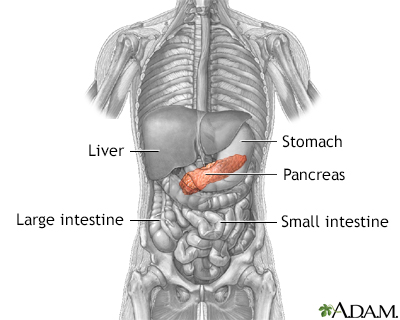Pancreatic abscess
A pancreatic abscess is an area filled with pus within the pancreas.
Images



Causes
Pancreatic abscesses develop in people who have:
- Pancreatic pseudocysts
- Severe pancreatitis that becomes infected
Symptoms
Symptoms include:
- Abdominal mass
- Abdominal pain
- Chills
- Fever
- Inability to eat
- Nausea and vomiting
Exams and Tests
Most people with pancreatic abscesses have had pancreatitis. However, the complication often takes 7 or more days to develop.
Signs of an abscess can be seen on:
- CT scan of the abdomen
- MRI of the abdomen
- Ultrasound of the abdomen
Blood tests will show high white blood cell count. A blood culture may grow bacteria.
Treatment
It may be possible to drain the abscess through the skin (percutaneous). Abscess drainage can be done through an endoscope using endoscopic ultrasound (EUS) in some cases. Surgery to drain the abscess and remove dead tissue is often needed.
Outlook (Prognosis)
How well a person does depends on how severe the infection is. The death rate from undrained pancreatic abscesses is very high.
Possible Complications
Complications may include:
- Multiple abscesses
- Sepsis
When to Contact a Medical Professional
Contact your health care provider if you have:
- Abdominal pain with fever
- Other signs of a pancreatic abscess, especially if you have recently had a pancreatic pseudocyst or pancreatitis
Prevention
Draining a pancreatic pseudocyst may help prevent some cases of pancreatic abscess. However, in many cases, the disorder is not preventable.
Related Information
AbscessPancreatic pseudocyst
Sepsis
References
Barshak MB. Pancreatic infection. In: Bennett JE, Dolin R, Blaser MJ, eds. Mandell, Douglas, and Bennett's Principles and Practice of Infectious Diseases. 9th ed. Philadelphia, PA: Elsevier; 2020:chap 76.
Forsmark CE. Pancreatitis. In: Goldman L, Cooney KA, eds. Goldman-Cecil Medicine. 27th ed. Philadelphia, PA: Elsevier; 2024:chap 130.
Law R, Baron TH. Endoscopic treatment of pancreatic disease. In: Feldman M, Friedman LS, Brandt LJ, eds. Sleisenger and Fordtran's Gastrointestinal and Liver Disease: Pathophysiology/Diagnosis/Management. 11th ed. Philadelphia, PA: Elsevier; 2021:chap 61.
Van Buren G, Fisher WE. Acute and chronic pancreatitis. In: Kellerman RD, Rakel DP, Heidelbaugh JJ, Lee EM, eds. Conn's Current Therapy 2024. Philadelphia, PA: Elsevier; 2024:175-182.
BACK TO TOPReview Date: 12/31/2023
Reviewed By: Jenifer K. Lehrer, MD, Department of Gastroenterology, Aria - Jefferson Health Torresdale, Jefferson Digestive Diseases Network, Philadelphia, PA. Review provided by VeriMed Healthcare Network. Also reviewed by David C. Dugdale, MD, Medical Director, Brenda Conaway, Editorial Director, and the A.D.A.M. Editorial team.

Health Content Provider
06/01/2025
|
A.D.A.M., Inc. is accredited by URAC, for Health Content Provider (www.urac.org). URAC's accreditation program is an independent audit to verify that A.D.A.M. follows rigorous standards of quality and accountability. A.D.A.M. is among the first to achieve this important distinction for online health information and services. Learn more about A.D.A.M.'s editorial policy, editorial process and privacy policy. A.D.A.M. is also a founding member of Hi-Ethics. This site complied with the HONcode standard for trustworthy health information from 1995 to 2022, after which HON (Health On the Net, a not-for-profit organization that promoted transparent and reliable health information online) was discontinued. |
The information provided herein should not be used during any medical emergency or for the diagnosis or treatment of any medical condition. A licensed medical professional should be consulted for diagnosis and treatment of any and all medical conditions. Links to other sites are provided for information only -- they do not constitute endorsements of those other sites. © 1997- 2025 A.D.A.M., a business unit of Ebix, Inc. Any duplication or distribution of the information contained herein is strictly prohibited.
